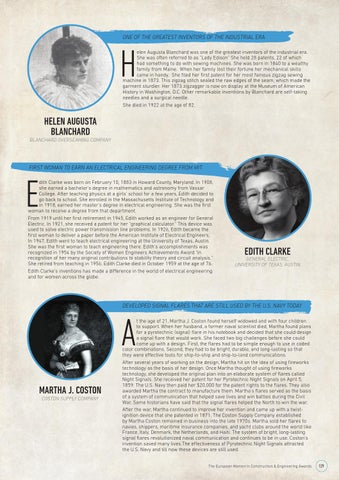ONE OF THE GREATEST INVENTORS OF THE INDUSTRIAL ERA
H
elen Augusta Blanchard was one of the greatest inventors of the industrial era. She was often referred to as "Lady Edison" She held 28 patents, 22 of which had something to do with sewing machines. She was born in 1840 to a wealthy family from Maine. When her family lost their fortune her mechanical skills came in handy. She filed her first patent for her most famous zigzag sewing machine in 1873. This zigzag stitch sealed the raw edges of the seam, which made the garment sturdier. Her 1873 zigzagger is now on display at the Museum of American History in Washington, D.C. Other remarkable inventions by Blanchard are self-taking needles and a surgical needle. She died in 1922 at the age of 82.
HELEN AUGUSTA BLANCHARD
BLANCHARD OVERSEAMING COMPANY
FIRST WOMAN TO EARN AN ELECTRICAL ENGINEERING DEGREE FROM MIT
E
dith Clarke was born on February 10, 1883 in Howard County, Maryland. In 1908, she earned a bachelor's degree in mathematics and astronomy from Vassar College. After teaching physics at a girls' school for a few years, Edith decided to go back to school. She enrolled in the Massachusetts Institute of Technology and in 1918, earned her master's degree in electrical engineering. She was the first woman to receive a degree from that department. From 1919 until her first retirement in 1945, Edith worked as an engineer for General Electric. In 1921, she received a patent for her "graphical calculator." This device was used to solve electric power transmission line problems. In 1926, Edith became the first woman to deliver a paper before the American Institute of Electrical Engineers. In 1947, Edith went to teach electrical engineering at the University of Texas, Austin. She was the first woman to teach engineering there. Edith's accomplishments was recognized in 1954 by the Society of Women Engineers Achievements Award "in recognition of her many original contributions to stability theory and circuit analysis." She retired from teaching in 1956. Edith Clarke died in October 1959 at the age of 76. Edith Clarke's inventions has made a difference in the world of electrical engineering and for women across the globe.
EDITH CLARKE
GENERAL ELECTRIC, UNIVERSITY OF TEXAS, AUSTIN
DEVELOPED SIGNAL FLARES THAT ARE STILL USED BY THE U.S. NAVY TODAY
A MARTHA J. COSTON COSTON SUPPLY COMPANY
t the age of 21, Martha J. Coston found herself widowed and with four children to support. When her husband, a former naval scientist died, Martha found plans for a pyrotechnic (signal) flare in his notebook and decided that she could design a signal flare that would work. She faced two big challenges before she could come up with a design. First, the flares had to be simple enough to use in coded color combinations. Second, they had to be bright, durable, and long-lasting so that they were effective tools for ship-to-ship and ship-to-land communications. After several years of working on the design, Martha hit on the idea of using fireworks technology as the basis of her design. Once Martha thought of using fireworks technology, she developed the original plan into an elaborate system of flares called Night Signals. She received her patent for her Pyrotechnic Night Signals on April 5, 1859. The U.S. Navy then paid her $20,000 for the patent rights to the flares. They also awarded Martha the contract to manufacture them. Martha's flares served as the basis of a system of communication that helped save lives and win battles during the Civil War. Some historians have said that the signal flares helped the North to win the war. After the war, Martha continued to improve her invention and came up with a twistignition device that she patented in 1871. The Coston Supply Company established by Martha Coston remained in business into the late 1970s. Martha sold her flares to navies, shippers, maritime insurance companies, and yacht clubs around the world like France, Italy, Denmark, the Netherlands, and Haiti. The system of bright, long-lasting signal flares revolutionized naval communication and continues to be in use. Coston's invention saved many lives.The effectiveness of Pyrotechnic Night Signals attracted the U.S. Navy and till now these devices are still used. The European Women In Construction & Engineering Awards
129
